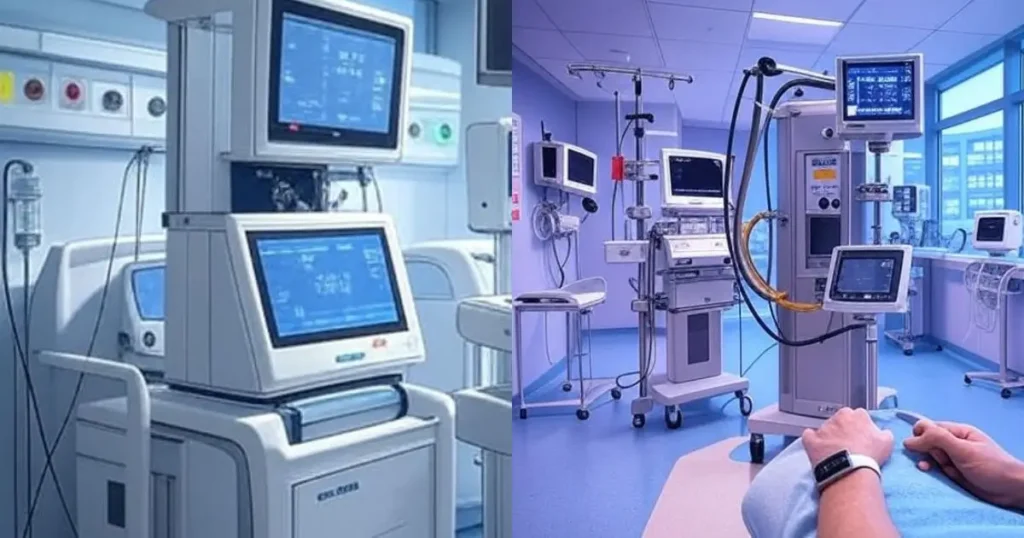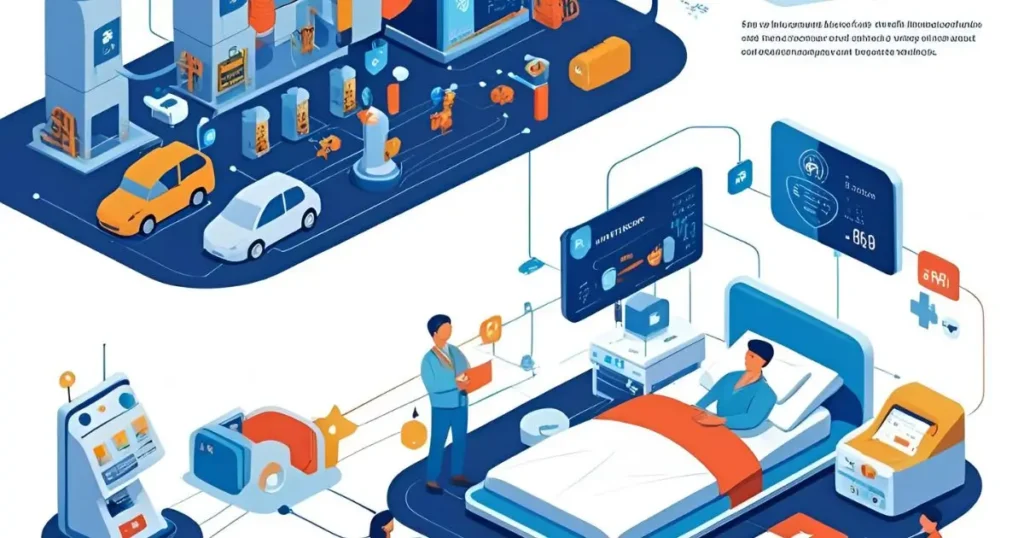Industrial internet of things (IIoT) and healthcare IoT (that’s the Internet of Things applied to health, by the way) are seriously shaking things up in factories and hospitals, and everywhere in between. Basically, it’s about hooking devices up to the internet so they can talk to each other, suck up data, and even automate stuff.
In this piece, we’ll break it down: what exactly they are, the different flavors, what they’re good for, and what headaches they can cause. Consider this your cheat sheet. Ready? Let’s jump in!
Topics Covered
Table of Contents
Industrial Internet of things (IIOT): What’s the Deal?
Imagine a factory where all the machines are chattering away, sharing information. That’s Industrial internet of Things (IIoT) in a nutshell. It’s a network of connected gizmos – machines, sensors, all that jazz – inside industrial settings. They use the internet to swap data, which helps factories (and other places) run like a well-oiled machine (pun intended!).
Think of it this way: A sensor on a piece of equipment can send data about how it’s performing. This Intel can predict when it’ll need some TLC, potentially preventing a big, expensive breakdown.
IIoT’s been brewing since the dawn of smart tech. It really took off with faster internet speeds and dirt-cheap sensors. Now, it’s powering everything from smart factories to energy grids. And it’s not just about speed, it’s also about keeping things safe. Apparently, McKinsey reckons IIoT could inject a whopping $14.2 trillion into the global economy by 2030. Crazy, right?
Healthcare IoT: A Dose of Tech for Your Health
Healthcare IoT is all about connecting medical devices to the web. We’re talking smartwatches, remote heart monitors, and so on. These things keep an eye on patients and ping data back to their doctors. They track everything from your pulse to your blood sugar levels. The beauty is, docs can check this data anytime, anywhere. Pretty nifty.
Remember those early fitness trackers? That was the starting point. Now it’s morphed into tools for hospitals and even virtual doctor’s visits. It’s not hyperbole to say it’s saving lives and making healthcare better. MarketsandMarkets predicts the healthcare IoT market will balloon to $188 billion by 2025. That’s a lot of digital thermometers!

How Do These Things Actually Work?
IIoT Workflow:
Sensing: Sensors grab data, like temperature or how much something is vibrating.
Connecting: This data zips over Wi-Fi or 5G to a central system.
Figuring Things Out: The system analyzes the data to spot problems or find ways to improve efficiency.
Doing Something About It: Tasks get automated, or a human gets pinged to take action.
Healthcare IoT Workflow:
Gathering Info: Wearable devices or implants collect health data.
Sending It Off: The data travels via Bluetooth or cellular networks.
Processing Power: Cloud systems crunch the numbers.
Doctor’s Orders: Doctors get alerts or tweak treatment plans.
They both hinge on real-time data and rock-solid networks. Oh, and “edge computing” helps by processing some of the data right there on the device, which speeds things up.
Different types of IIoT and Healthcare IoT
Here’s a quick rundown of the different types you’ll run into:
Industrial Internet of Things (IIoT):
1. Manufacturing IoT: Think of it as making production lines smarter.
2. Energy IoT: Managing power grids and renewable energy sources, like solar.
3. Transportation IoT: Keeping tabs on vehicles and logistics – from trucks to trains.
4. Agriculture IoT: Monitoring crops and farm equipment.
Healthcare IoT:
1. Wearable Devices: Smartwatches, fitness trackers, you know the drill.
2. Implantable Devices: Pacemakers and insulin pumps.
3. Remote Monitoring: Tools for checking on your health from home.
4. Hospital IoT: Connected beds and imaging systems.
What Can They Actually Do?
Industrial Internet of Things (IIoT):
Predictive Maintenance: Spotting machine problems before they cause chaos.
Supply Chain Visibility: Tracking goods in real-time for better management.
Smart Factories: Automating production lines to boost efficiency.
Energy Management: Optimizing how power is used
Healthcare IoT:
Patient Monitoring: Keeping tabs on vital signs remotely.
Telemedicine: Virtual doctor’s appointments.
Medication Management: Reminders to take your meds.
Hospital Efficiency: Automating bed assignments and equipment tracking.
You’ve probably heard stories about this stuff in action. General Electric, for example, uses IIoT to monitor jet engines. And Apple Watches can now detect heart problems and alert users. Pretty amazing, huh?

The Upsides: Why Bother?
Benefits of IIoT:
Efficiency Boost: Automates tasks and saves time.
Money Savings: Reduces downtime and waste.
Safety First: Monitors hazards to protect workers.
Smarter Decisions: Data insights help you make better choices.
Healthcare IoT:
Better Care: Improves patient outcomes with real-time data.
Accessibility: Helps people in remote areas get the care they need.
Early Detection: Spots health issues early.
Reduced Costs: Lowers the number of hospital visits.
Deloitte says IIoT can potentially slash maintenance costs by around 30%. And according to HealthIT Analytics, IoT in healthcare can cut hospital readmissions by about 20%. Those are some serious numbers!
The Downsides: What to Watch Out For
Challenges of IIoT:
Security Nightmares: Hackers love connected machines.
Pricey: Setting up these systems can be a real investment.
Integration Issues: Getting older machines to play nice with new systems can be a pain.
Downtime: Network hiccups can bring the whole thing to a screeching halt.
Challenges of IoT in Healthcare:
Privacy Worries: Patient data breaches are a huge concern.
Reliability is Key: These devices absolutely must work flawlessly.
Affordability: Advanced tools can be too expensive for smaller clinics.
Regulation Overload: Medical devices are subject to strict laws.
IBM has warned that cyberattacks on IIoT systems increased high in 2024. And the Department of Health and Human Services (HHS) estimates that data breaches are also increased. Yikes!
Quick Comparison between IIoT and IoT in Health
| Aspect | IIoT | IoT in Health |
| Primary Use | Industrial automation | Patient care and monitoring |
| Key Devices | Sensors, robots, machinery | Wearables, implants, monitors |
| Main Benefit | Efficiency and cost savings | Improved health outcomes |
| Main Challenge | Security and integration | Privacy and reliability |
| Example | Smart factory production | Remote heart rate monitoring |
The Future of IIoT and IoT in Health
Industrial Internet of Things (IIoT):
5G Speed: Faster connections for better performance.
AI Brains: AI will get even better at predicting failures.
Going Green: Helps reduce energy consumption.
Robots Everywhere: More automation in factories.
Healthcare IoT:
AI Diagnoses: AI will analyze data to help with diagnoses.
Smarter Wearables: New sensors will track even more health metrics.
Personalized Care: Tailored treatments for patients.
Global Reach: More access to healthcare in developing areas.
Ericsson predicts 5G will boost IIoT speeds by a factor of 100. And the World Health Organization (WHO) thinks AIoT could save millions of lives yearly.
Final Conclusion
Industrial Internet of Things and healthcare IoT are transforming how we work and how we care for ourselves. The benefits are clear, but we need to tackle those security and cost challenges head-on. With advancements like 5G and AI, the future looks incredibly promising.
FAQ’s
1. What’s IIoT used for, in a nutshell?
Ans. Automating factories, predicting maintenance, and managing energy.
2. How does IoT help health?
Ans. Monitoring patients remotely and improving telemedicine.
3. What are the biggest risks?
Ans. Security breaches and high costs.
Pingback: What is Inter-IoT? A complete Guide to understand its top 5 Layers
Pingback: Boom of Health and Home Technologies: Explore powerful top 5
Pingback: The Bright Future of AI Agents: Learning, Adapting, and Innovating in 2025
Pingback: Amazing Stroy of New Horizons: Historic Mission (2006-2028)